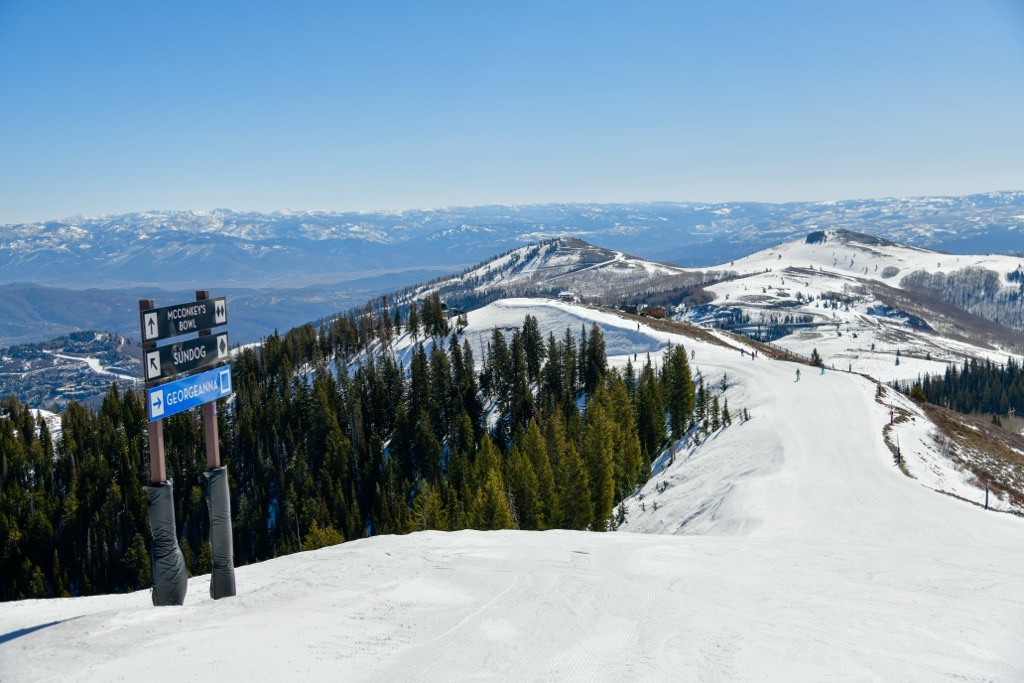Get PeakVisor App
Sign In
Search by GPS coordinates
- Latitude
- ° ' ''
- Longitude
- ° ' ''
- Units of Length
- Temperature

Yes
Cancel
Share ×

Scan the QR code and open PeakVisor on your phone
❤ Wishlist ×
Choose
Delete
Alta Ski Area is the king of old-school “steep and deep” skiing. With dozens of runs over 40 degrees, the resort’s sheer terrain offers some of the most challenging skiing in the US. Alta is also notably one of the snowiest resorts in the US (and the world), nestled in the upper reaches of the Wasatch Mountains of Utah in a rounded basin with a unique microclimate. Alta averages an astounding 545” (1,384 cm) of snow annually. The resort has 2,614 skiable acres (1,058 hectares) of terrain covering 2,538 ft (774 m) of vertical. Six chairlifts and three surface lifts service 119 named runs. The resort’s boundary encircles two significant drainages: Albion Basin and Collins Gulch. The highest point in the resort is the summit of Mt. Baldy, 11,068 ft (3,374 m). It is also (famously and controversially) one of three remaining US resorts prohibiting snowboarders.
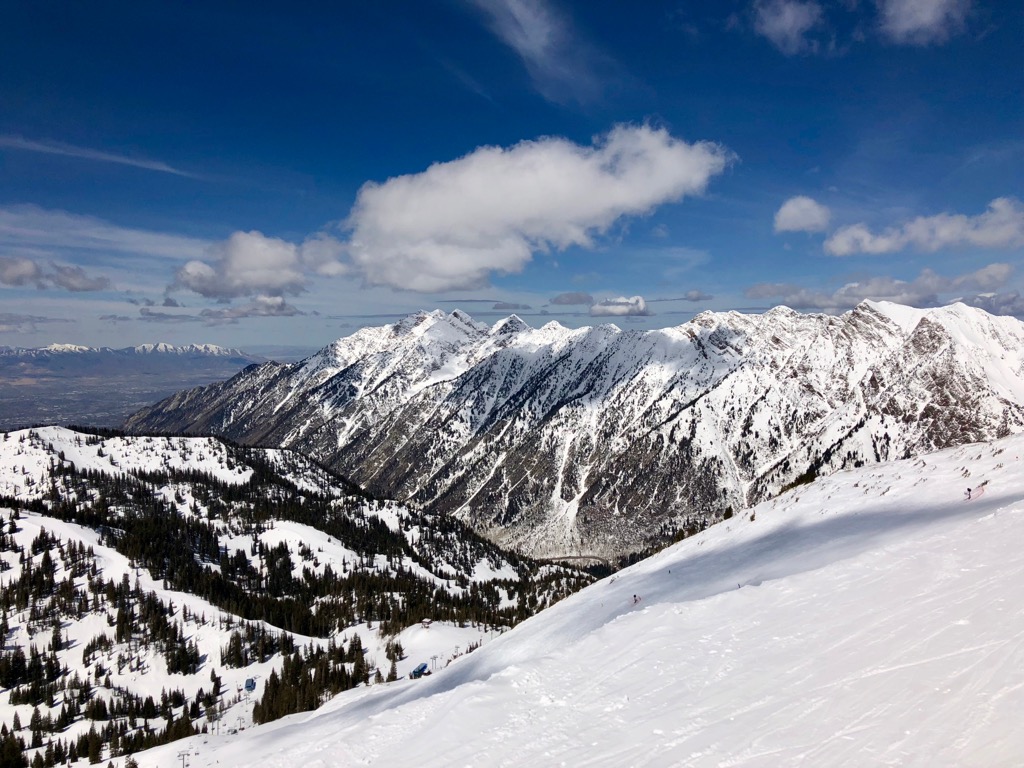
Alta Ski Area is technically in Alta, UT, a historic mining-turned-resort town in Salt Lake County, just east of Salt Lake City. However, there isn’t much of a town in the traditional sense, just a few vacation homes.
The resort's land is partly private and partly managed by Uinta-Wasatch-Cache National Forest, a vast area of public land that flanks Salt Lake City, Ogden, and Provo. The forest includes three major mountain ranges: the Wasatch, Uinta, and Bear River Ranges of Utah.
Alta is in Little Cottonwood Canyon, a U-shaped glacial trough featuring some of the best skiing in Utah. Alta sits on the ridgeline's north slope, capped by three peaks: Devil’s Castle (10,920 ft, 3,328 m), Sugarloaf Peak (11,051 ft, 3,368 m), and Mount Baldy.
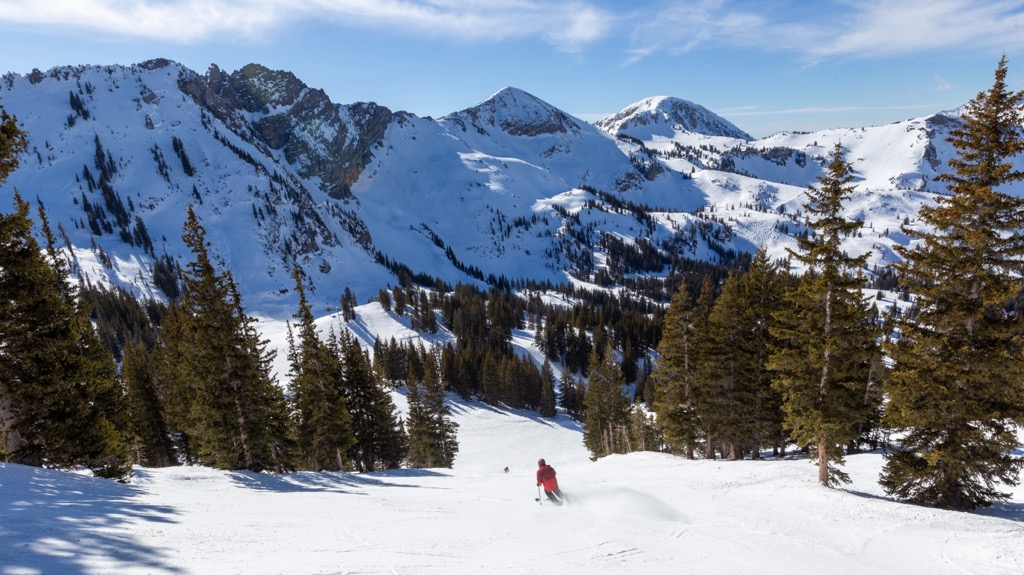
The resort is flanked by Mount Superior (11,045 ft, 3,367 m) and Mount Wolverine (10,795 ft, 3,290 m), which offer world-famous ski lines. Mount Superior is one of the 50 Classic Ski Descents of North America, and Mt. Wolverine hosts a gallery of incredibly steep chutes and cliffs. Snowbird and Brighton Ski Resorts also neighbor Alta.
Over the last decade, increasing congestion in the Salt Lake City area has created a serious issue for skiers traveling up Little Cottonwood Canyon. Honestly, the most challenging part of skiing Alta today is getting up the canyon.
Salt Lake City International Airport is a major thoroughfare in the western US, with daily flights to and from every major city in the country. From the airport, it’s an hour's drive south and east via I-15 to Little Cottonwood Canyon. Alta sits at the very top of the canyon.
However, access to the canyon regularly closes in the winter due to extreme avalanche danger along the road. Traffic proves to be a serious obstacle, especially on powder days and weekends. Locals have dubbed this phenomenon ‘the red snake’ because of the brake lights snaking the entire way down the canyon as skiers trickle back into SLC.
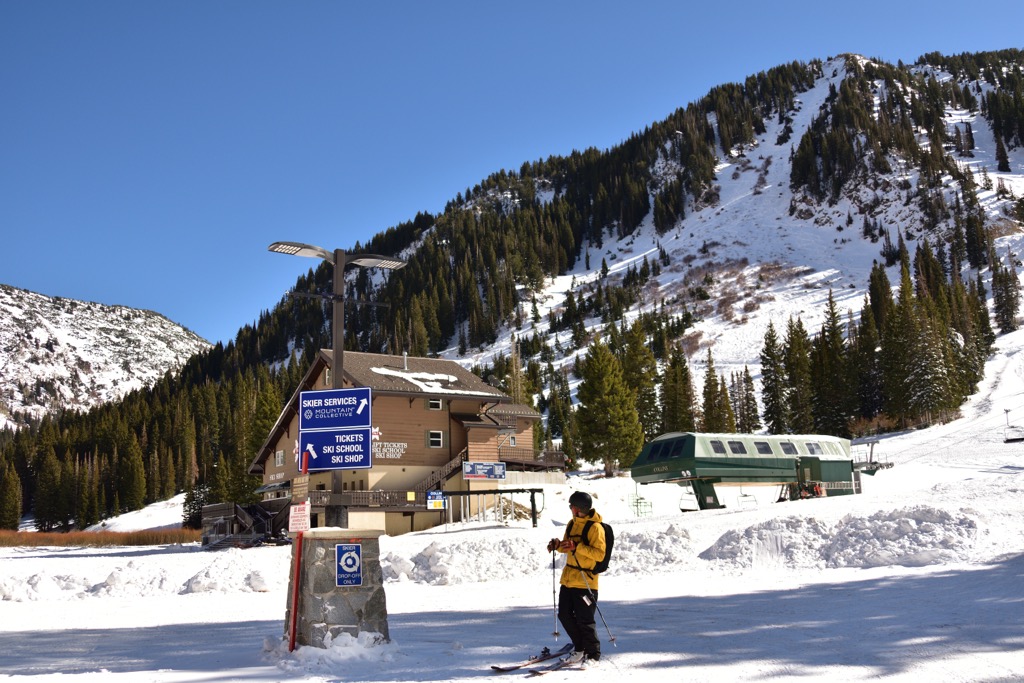
Luckily, there is a safer and quicker way to Alta than by car: the UTA Ski Bus. Buses are free to season pass and IKON pass holders. Otherwise, it costs $4.50 per rider, much cheaper than paying for parking.
The best advice I can give newcomers to Salt Lake City is to get an early start to the day and obey traffic laws. Local law enforcement commonly turns away cars ill-equipped to drive in the snow. On storm days, traction devices like chains or 4x4 are required to enter the canyons.
Once you’re at the mountain, you’ll have two options for parking. I recommend beginners park at Albion Base Area, the further of the two parking lots. This area services all of the mountain’s beginner terrain. Wildcat Base area services Collins Gulch, one of the most challenging areas at the resort. However, regardless of where you park, a rope tow (the Transfer Tow) connects the two base areas to make traveling around the mountain easier. If you are staying at the resort, two flat chairlifts and one rope tow will connect you from your lodging to the Transfer Tow.
Alta’s opening and closing dates are dependent on snowpack. Generally, opening day is the third or fourth week of November. Closing day is usually the third or fourth week of April. Neighboring Snowbird will often stay open until the end of May (IKON and those who own the dual season pass can keep skiing).
Part of the magic of skiing Alta is how reliable the snowpack is. Naturally, there are both good and bad winters at Alta. But compared with the surrounding resorts, you can be confident that Alta will have a good snow base every winter. For example, Alta’s worst winters in history have still produced more snowfall than an average winter in Colorado.
Utah winters commonly start slow, with guests trickling in until late December or January. Once the powder panic sets in, Alta becomes very busy. The crowds usually last most of the season, from the winter holidays until the end of March. February and March are the busiest months (as well as the Christmas holiday).
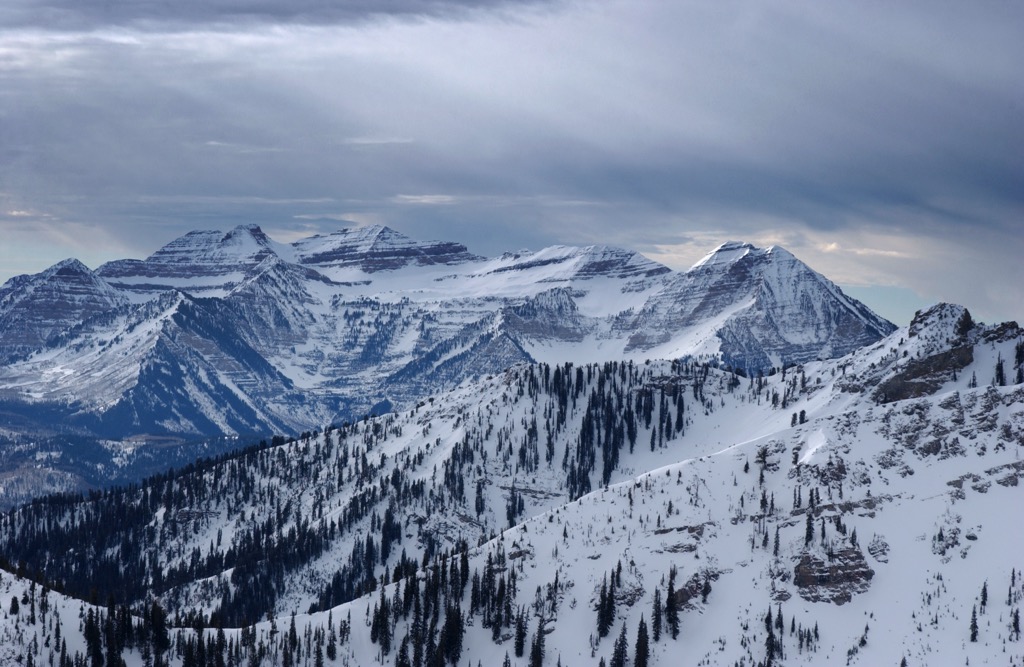
But once the weather gets warmer, people often lose interest in skiing and leave the resort deserted. Don’t be fooled - March and April see massive snow accumulations in the Wasatch. These springtime “sleeper powder days” will sometimes greet an empty mountain, allowing a few diehard skiers to soak up the fantastic bluebird powder conditions.
And it’s not all about skiing powder at Alta, either. Sunny corn skiing days are fantastic here as well. Regardless of the conditions, I firmly believe spring skiing at Alta has a higher potential than early or mid-season skiing. True, the mid-season may see more snow days, but it also brings more people competing for the snow. Springtime brings the right balance of excellent conditions and space to enjoy yourself.
Utah’s unofficial slogan, emblazoned on license plates and signs across the state, is “The Greatest Snow on Earth.” Skiing conditions in Utah are often compared to those in Japan. Both places receive loads of soft, fluffy “champagne” powder (Utah has better terrain and a longer season, but way more people).
This snow consistency is produced at a snow-water equivalent ratio of 12:1, meaning one inch of precipitation (water) makes 12 inches of snow. This 12:1 ratio is a kind of “magic number.” It’s a happy medium between the wetter, heavier “Sierras cement” snow in California and the dusty, barely-there “cold smoke” snow often seen in Idaho and Montana. Nevertheless, Utahans still take their fair share of super-blower powder, especially in Little Cottonwood Canyon, where the orographic enhancement can create an extra few inches of powdery snow at the storm's end.
Frequently, storms fall ‘right side up,’ meaning the snow on the bottom is denser than the snow on top. These storms give the skiing that enviable ‘bottomless’ quality while improving avalanche conditions - ‘upside down’ storms notoriously produce large avalanches.
As I mentioned, Alta averages 545 inches (1,384 cm) of snow per season. During intense La Niña years (like 2022-2023), snow totals can reach 730 inches (1,854 cm) or even more. It is not uncommon for Alta to see storm totals of more than 60 or 70 inches (152-178 cm) in a few days.
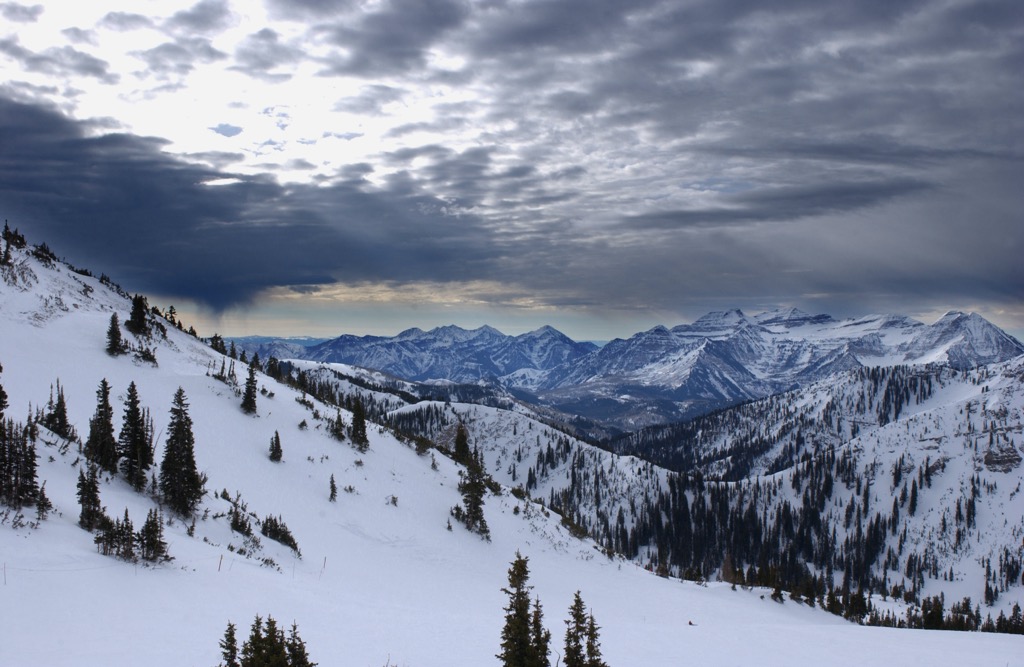
Storm days at Alta are usually excellent skiing as well. Plenty of trees grow throughout the resort to offer contrast and visibility. Rocks and ridges provide additional landmarks. Moreover, the mountain isn’t known for being very foggy. The dry, desert climate discourages rime ice and other conditions that can hurt visibility. Most importantly, storm days are commonly followed by immaculate “bluebird” conditions, with fresh powder and cloudless skies.
While big storms make for unbelievably good powder skiing conditions, they can also produce deadly avalanches. And make no mistake, Alta is a shooting gallery for avalanches. The resort is ringed in on all sides by slopes that regularly avalanche; it’s not uncommon for Little Cottonwood Canyon to be closed all day. Gigantic slabs commonly slide down the mountainside and bury parked cars under feet of snow. As such, it’s wise to watch the avalanche forecast and read ahead about conditions.
However, if you manage to stay at the resort overnight when the canyon is closed, you may be in for one of Alta’s legendary unicorn days. The resort sometimes opens when the canyon is closed and serves as a private powder country club for just a few skiers. If you have a day like this, you’ll remember it for the rest of your life.
Alta’s ski map effectively represents the terrain, although the scale of the features on the mountain can be a little confusing. Check out the PeakVisor topographical rendering for a better idea of the resort’s terrain, particularly the off-piste sections.
Alta consists of two drainages that funnel upward to three peaks. The canyon on the left is Albion Basin, and the canyon on the right is Collins Gulch. Between these two alpine canyons is a tall, narrow ridge topped by a rocky buttress called East Greeley. The Albion Basin side of this ridge is called Greely, and the Collins Gulch side is called Rustler.
The main difficulty navigating Alta is getting from one canyon to the other. You can do this at the bottom with the transfer tow or at the top. To get from Albion Basin to Collins Gulch, you’ll have to take two lifts: Albion or Sunnyside and then Sugarloaf, which drops into the top of Collins Gulch. The Sugarloaf lift also gives good access to Sugarloaf Peak, East Baldy, the Mt. Baldy Summit, and the entire spine of the Greely/Rustler ridge.
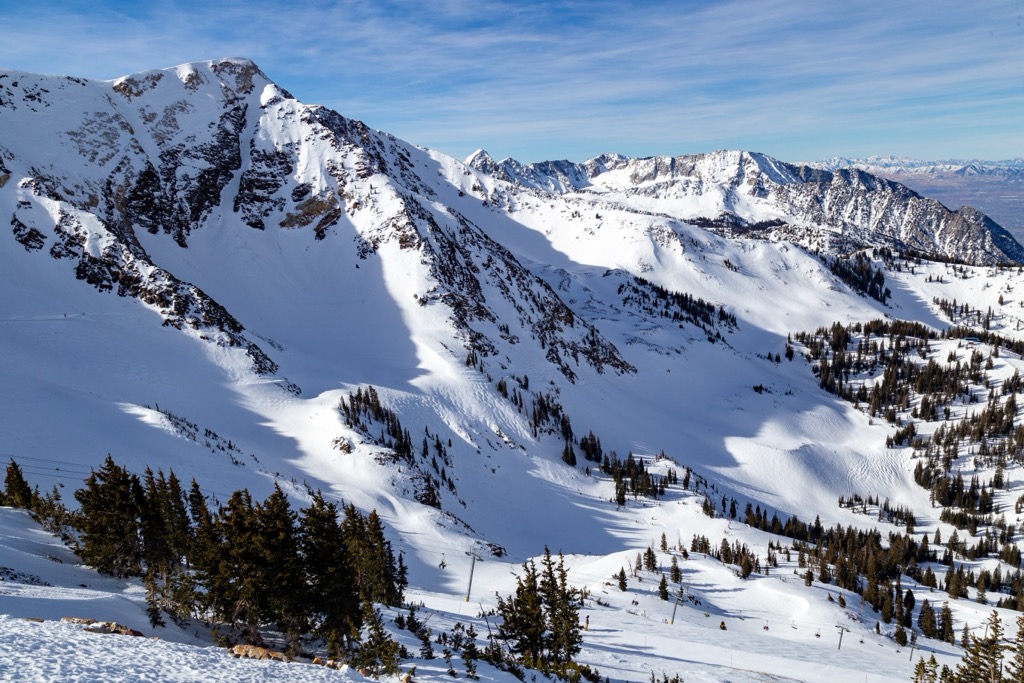
To get from Collins Gulch to Albion Basin, hop on Collins lift and traverse to the looker’s left and over the pass. The Collins lift is also the main access point for the entire Greeley/Rustler ridgeline, where some of the mountain’s steepest terrain is. The far right side of Collins Gulch is accessible by the Wildcat lift or by taking Collins and traversing under Mt. Baldy.
The Supreme lift accesses the mountain's extreme opposite (looker’s left) side. Supreme serves a considerable area, including Supreme Bowl, Catherine’s, the East Castle, and Castle Apron. The Supreme and Sugarloaf lifts both start midway up the mountain. You can take Albion, Sunnyside, or Collins to get to either.
Be sure to note the three gates where you can transfer from Alta directly into Snowbird Resort. All three gates are on the resort’s west (looker’s right) side.
The first two are accessible by way of Wildcat Lift. Keyhole Snowbird Gate is at the top of the lift, to the looker’s right. Following down this ridgeline, which separates Collins Gulch from Peruvian Gulch, you’ll spot White Cliffs Snowbird Gate. The third gate sits on the ridge between Sugarloaf Peak and Mt. Baldy, called the Sugarloaf Pass Snowbird Gate. If you have a pass that allows access to both mountains, you can use these gates for skiing directly between the two resorts.
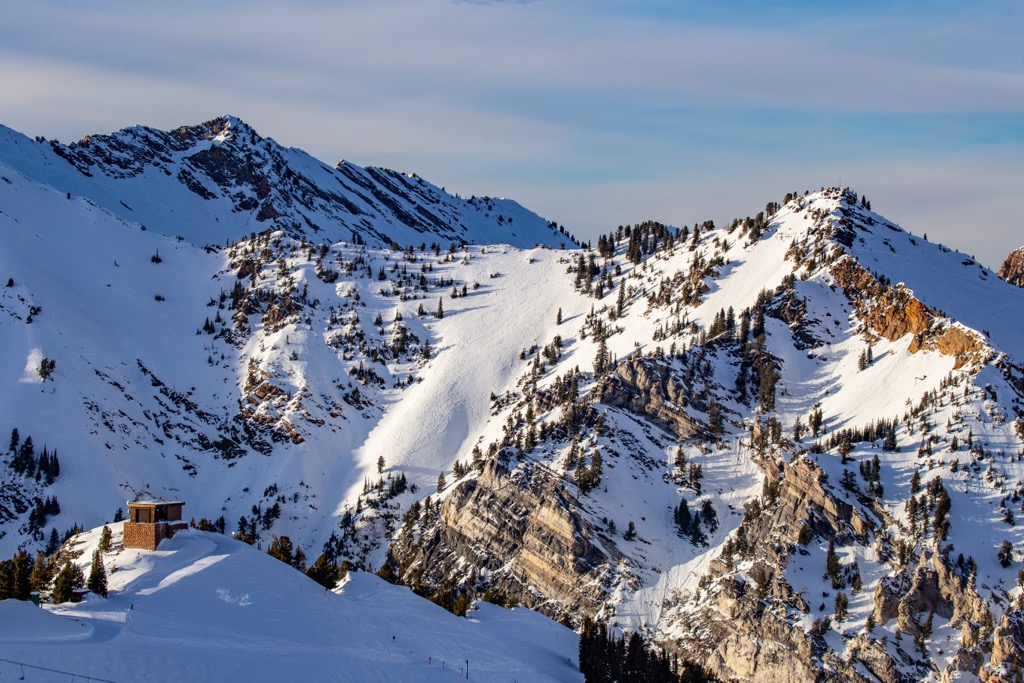
Slopes
Ski lifts

Other features and services

Let’s begin our exploration of the Alta Ski Area at Albion Base. Albion is the best place for beginners and newcomers to the mountain to start. The lower half of Albion Basin, accessible by Sunnyside and Albion Lifts, is where the only beginner (green) runs at Alta are. This part of the resort sits on the flanks of Mount Wolverine, called Patsy Marley. It’s sparsely forested and full of gentle slopes.
Intermediates will want to branch out from here. The most obvious option is to head to Supreme or Sugarloaf Lifts, both of which serve a lot of intermediate (blue) terrain. Supreme’s intermediate terrain, especially the area under East Castle and Castle Apron, winds in and out of trees and offers some diversity. Sugarloaf serves more open, steeper terrain that is spectacular on powder days. From the top of Sugarloaf, you can also drop into Collins Gulch and explore the many gullies and glades that run lengthwise down the canyon. This is a spectacular spot for intermediates to learn about steep skiing. Take Collins back up from the bottom and pick your way back down.
Experts have the lion’s share of the terrain at Alta. You may have noticed by now that Alta doesn’t differentiate between “advanced” (black diamond) and “expert” (double black diamond) terrain. The ceiling for difficulty in Little Cottonwood Canyon is much higher than in most places.
You could compare the LCC resorts to somewhere like Jackson Hole Mountain Resort or Palisades Tahoe. Runs normally considered blacks are only rated blues, and runs that typically wouldn’t even be in bounds are rated blacks. One of the most striking things about Alta is the concentration of incredible skiers, especially on powder days. You’ll see young powderhounds hucking their meat off various features throughout the resort.
But don’t let that discourage you. Alta’s challenging steeps, natural lips, cliffs, and gullies are unique and fun on powder days. So, as an expert, where should you start?
It depends on what you’re in the mood for. One of my favorite areas at Alta is Wildcat, an old-school two-seater chairlift that hasn’t changed a day in decades. It services an intense, forested slope on the looker’s right of Collins Gulch with a million secrets to discover. You could easily spend a whole day just lapping this part of the mountain, taking a different line down every time.
Right next door is Collins Lift, home to some of the steepest slopes at Alta. I’m referring, of course, to West Rustler and everything accessible off the High Traverse. Runs like Alf’s High Rustler, a legendary steep gully that exceeds 45 degrees, and Eagle’s Nest are at the tail end of this traverse. These two are absolute must-ski runs for Alta newcomers.
The Backside Area, including Yellow Trail and East Greeley, is also accessible from the top of Collins. The Backside is one of the controlled access areas at Alta, which may be closed due to avalanche or weather conditions. But if you catch it on the right day, you’re in for a great run. The entire east (looker’s left) face of the Greeley/Rustler ridge is full of incredible open-face skiing that is absolutely unbeatable on a deep powder day.

You can also get to these areas via Sugarloaf Lift. Sugarloaf also allows access to the Cecret Chutes, Cecret Saddle, and the looker’s left side of Yellow Trail. This area has a lot of mixed open and tree skiing, almost entirely off-piste, and skis fabulously on powder days.
Moving further left, we return to Supreme. Supreme is a realm of its own within Alta. In addition to the less steep forested terrain on the looker’s right side of the lift, it also services two controlled access areas: Catherine’s and Supreme Bowl, defined by their steep, shady trees perched atop drops and cliffs. If you commit to dropping into this side of the resort, just remember to traverse west toward the resort before you get too low. There is a long, slow traverse that you’ll need to catch, or else you can end up out of bounds in a broad, flat area that’s a pain to hike out of.
It’s impossible to visit Alta without hearing about the snowboarding ban. Many people have the wrong idea about this ban, so I will try to clear the air. Alta didn’t ban snowboarders because of some pretentious prejudice toward a lower class of people. Instead, snowboards are almost entirely useless at this resort - there’s simply too much traversing.
Alta operates only six lifts across a vast ski area. Nearly every run requires some kind of traverse at the top, bottom, or middle. Many of these traverses require literally sidestepping up the mountain - the snow is often too deep to take off your skis. Unaware snowboarders would likely get stuck all over the mountain, causing issues for ski patrol. Most snowboarders would ride one day at the resort and then return to Snowbird voluntarily, where the mountain is much friendlier for snowboarders.
It’s not just snowboarders; new skiers should be aware. Every local skier knows Alta stands for ‘Another long traverse again.’ No powder wonderland comes for free, and Alta is no exception. Like any well-known ski resort, you need to work for the goods.
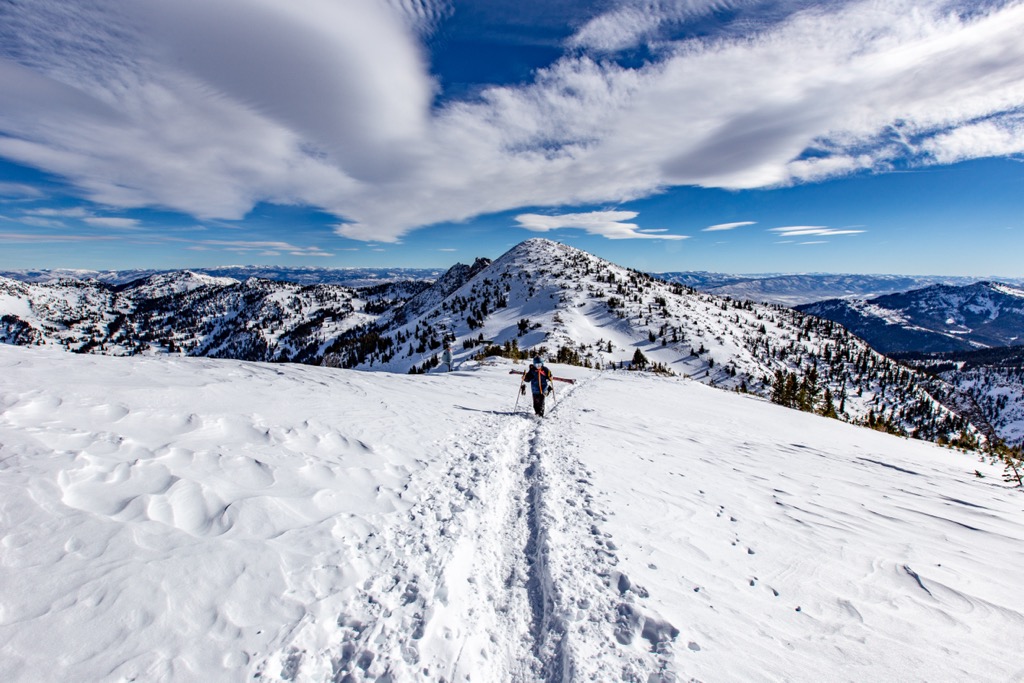
With that, we’ve covered everything you can get to by skiing down from the top of a chairlift. But there are still lots of areas that you can’t get to by lift alone. Some of the best terrain in and around Alta is only accessible by touring or boot-packing.
Let’s discuss Alta’s three peaks: Devil’s Castle, Sugarloaf, and Mt. Baldy. The bootpack for Devil’s Castle is accessible from the top of Supreme Lift. Uphill routes are gated and marked and will often close due to weather or avalanche hazard. From Devil’s Castle, you can access the East Castle, one of the most locally famous runs at Alta, as well as Castle Apron.
Riding the Sugarloaf Lift easily accesses the other two peaks. Getting off the lift, you’re already sitting on top of Sugarloaf Pass. To get to the top of either mountain, you’ll just hike or skin up the ridgelines.
Most people don’t ski from the summit of Sugarloaf Peak. Instead, the most popular line is to traverse under the mountain’s cliff band and drop into the lower bowl, confusingly called Devil’s Castle. This broad, open bowl is one of Alta’s most coveted lines on a deep powder day.
There are many options from the summit of Mt. Baldy, including Baldy Chutes, East Baldy, and the Baldy Shoulder. The terrain here is some of the steepest at Alta, and the exposure is exhilarating.
Alta also provides access to some of the best ski touring in the US, right outside the resort boundary. I’m talking about two areas in particular here: Catherine’s Pass and Grizzly Gulch.
Catherine’s Pass is the high mountain pass that separates Alta from Brighton Resort. The vicinity includes many objectives, like Mt. Tuscarora, with the sought-after Seagull Chute. Other accessible lines include Martha Bowl, the Dog Lake Chutes, and the Upper Lake Mary Chutes.
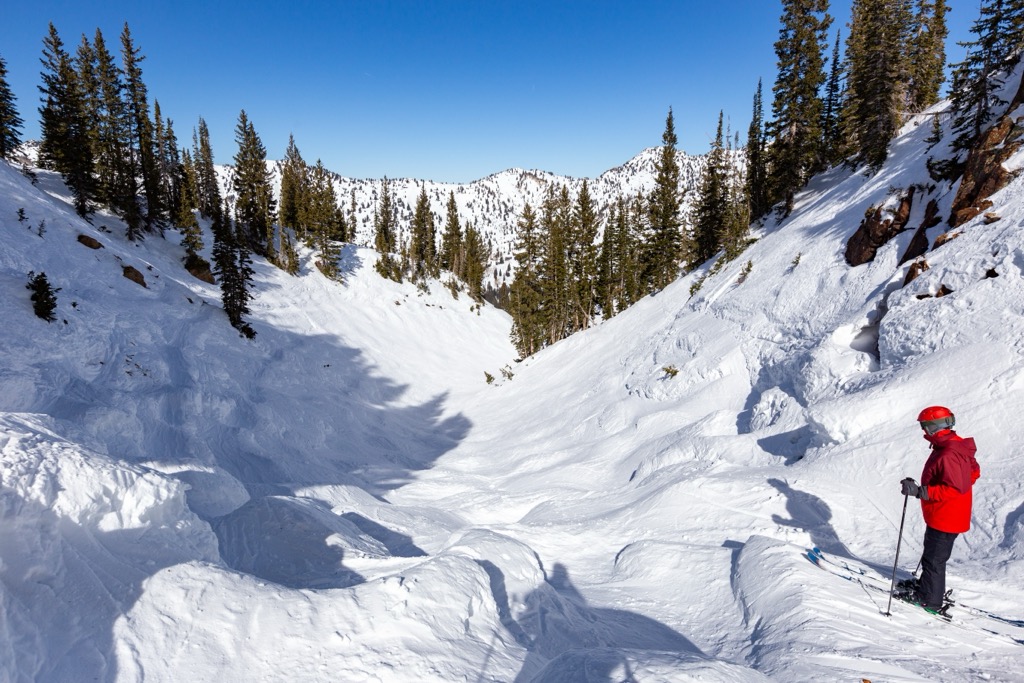
Grizzly Gulch is one of Utah's most coveted powder skiing destinations. It’s a long canyon ringed in open fields that often load with deep powder. At the very top of Grizzly Gulch is the Wolverine Cirque, a gallery of very steep, high-intensity chutes and cliffs. These are some of the most technical lines in the Wasatch Mountains and are bucket list items for many locals.
Day passes to Alta Ski Area range from $139 to $174, depending on how far out you reserve them and the day of the week. Alta considers everyone older than 12 an adult, so there is really only one price for day tickets. The best way to get a discount on day passes is to buy a Gold Card, which offers unlimited tickets at 50% off the window rate.
They do offer cheaper passes for beginners, however. If you’re just planning on riding Sunnyside, you can get passes for anywhere from $19 to $74. Afternoon tickets are also slightly cheaper, ranging from $65 to $142.
There are significantly more options for season passes at Alta, including midweek and unlimited season passes ($999 and $1,599, respectively), as well as reduced rates for young adults (ages 18-25), active duty military, ages 65-79, and ages 80+. Youth season passes range from $99 to $719, depending on age.
Alta also offers package deals for families and Alta-Snowbird joint season passes. If you’re trying to experience everything Little Cottonwood Canyon offers, the Alta-Bird Pass is the best way. Adult prices range from $2,049-$2,249.
Lastly, Alta is on the IKON Pass. If you’re unfamiliar, the IKON Pass gives you a certain number of days (depending on the tier you purchase) to many mountains around the United States. IKON is a fantastic way to ski dozens of mountains around the US for a steeply discounted rate - passes start at $439, but the full pass is about $1000 if you purchase early.
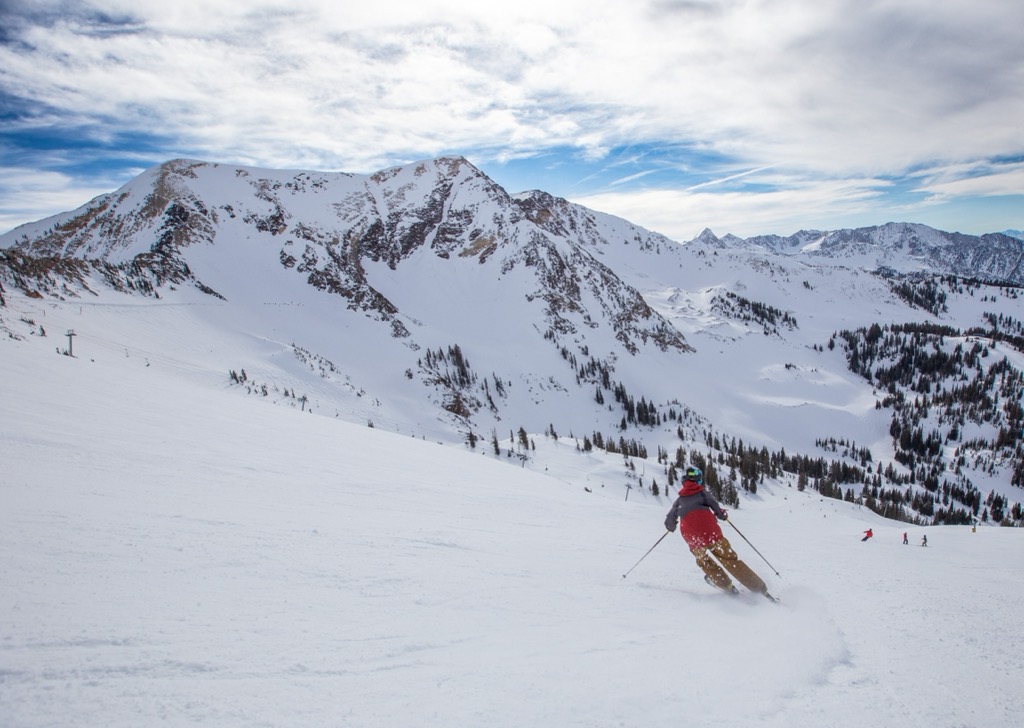
Before or after skiing, visit the resort’s and the region's official tourist offices, located in the town of Alta, just east of Salt Lake City:
Alta Ski Area Info
10010 Little Cottonwood Canyon Rd, Alta, Utah (UT), 84092, United States
Reservations: Alta Lodging Site
Information: 801.359.1078
General inquiries: info@alta.com
Alta Chamber & Visitors Bureau
10351 Utah Highway 210, Alta, Utah (UT), 84092, United States
Open seven days per week in the winter, 8:00 am to 6:00 pm
+18882582916
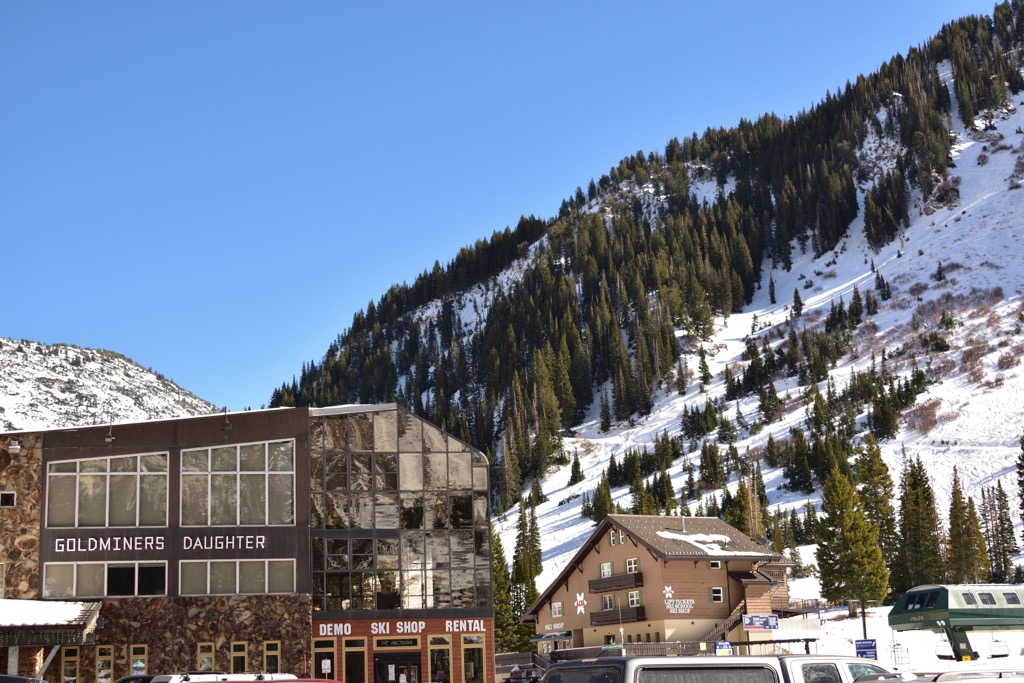
The town of Alta is tiny. So tiny, in fact, that it’s almost synonymous with the resort. There aren’t places to eat outside the resort-operated restaurants and bars in Little Cottonwood Canyon. However, Salt Lake City is a food hub - you’ll find affordably-priced cuisine from all over the world.
But there are still plenty of options for dining, alcohol, and coffee at the resort. Two mid-mountain lodges and a handful of lodges and restaurants are scattered between the two base areas of the mountain.
The most convenient options from the parking lot are Albion Day Lodge and the Goldminer’s Daughter. Each of these lodges has a restaurant and cafe. Goldminer’s Daughter is also home to the local favorite on-mountain bar, the Goldminer’s Saloon. On the high-end side, you can also find the dining lodge at Alta Peruvian Lodge at Wildcat Base Area.
Snowpine Lodge, Rustler Lodge, and Alta Lodge are between the base areas. The Eagle’s Nest at Rustler Lodge is a top choice for upscale après. Snowpine Lodge has you covered for dinner and drinks with Swen’s Restaurant and the Gulch Pub. And if you’re staying at Alta Lodge, you can grab a bite at the lodge dining room, with breakfast, lunch, and dinner served daily.
If you’re just after a quick bite, each of the resort’s canyons has a mid-mountain lodge. Alf’s, located in Albion Basin, has a restaurant and cafe. In Collins Gulch, Watson Shelter is the place to be for dining and coffee on the go.
There is a combination of resort-owned and AirBnB-type lodging around Alta. Like most major ski destinations, the sky's the limit for luxury at Alta. The Peruvian, Rustler, and Snowpine lodges offer luxury lodging a stone’s throw from a chairlift.
But there are also lovely lodging options just around the corner. Generally, AirBnB rentals nearer to Albion Base Area are more expensive, running upwards of $2,000 per night. On the low end, you can find rentals for around $350 per night at the resort.
Lodging options have become much more affordable outside Little Cottonwood Canyon. You can easily find an AirBnB minutes from the canyon for less than $100 per night. And if you’re willing to drive 10-15 minutes to the canyon, you can easily find lodging for less than $30 in the Sandy neighborhood of Salt Lake City.

Alta has an ongoing calendar of events, with new things constantly popping up. But there are two in particular that are special for Alta.
The first is the Torchlight Parade, an annual winter celebration typically around New Year’s Day. On this dark, cold, midwinter night, Alta fires up the chairlifts and loads 500 skiers to the top of the resort. Then, the skiers pop open road flares and ski back down, creating a glowing river of light. The night is capped off with a fireworks show.
The second is Alta’s closing day celebration, known as Frank. Frank is the ultimate “Gaper Day” celebration, where skiers dress up in ridiculous clothes and go all-out, skiing and partying harder than ever. It’s a fantastic celebration of another year at Alta Ski Area. Antics, backflips, beers, and laughs abound. It’s the kind of thing you need to experience firsthand to understand.
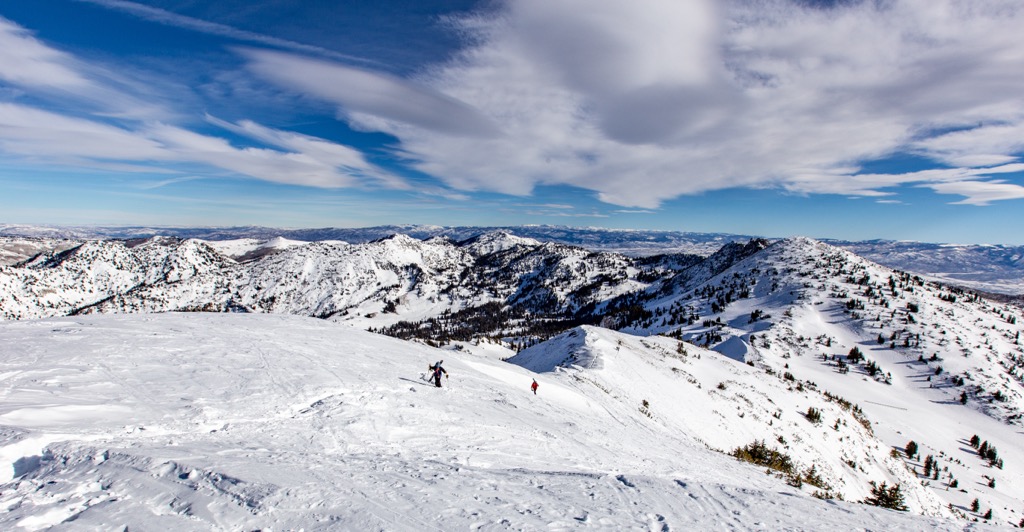
As I mentioned, Alta is surrounded by ski resorts at the heart of the Wasatch Mountains. To the west is Snowbird, another expansive resort famous for its powder snow and big mountain terrain. Alta and Snowbird are interconnected; you can easily ski both on the same day with the dual season pass (however, there’s no day pass). Snowbird has more lifts but also more skiers than Alta. Both resorts can get crowded, but Snowbird is more likely to be mobbed. Also, any group with at least one snowboarder will have to ride at Snowbird.
However, the terrain at Snowbird is even better than Alta if you’re an expert. The tram will take you 3,000ft to the summit, where you can descend steep chutes and open bowls the whole way down. Dozens of different zones make this place a paradise for powder-seeking freeriders.
To the northeast is Brighton (Utah’s first ski resort), which is much smaller and popular with locals, especially in the freestyle skiing and snowboarding scenes. Directly north of Alta is Solitude Mountain Resort. Brighton and Solitude are next-door neighbors, and skiers can ski between them the same way you can between Alta and Snowbird. These four resorts are the most easily accessible from Salt Lake City.
As the crow flies, Park City Mountain Resort and Deer Valley Resort are next to Alta. These ski areas are easily accessible from Park City, which became a major tourist destination after the 2002 Winter Olympics. Park City Mountain Resort is known for being the largest ski resort in the United States. Deer Valley, like Alta, is a skiers-only resort that prides itself on being the most luxurious ski destination in the state.
